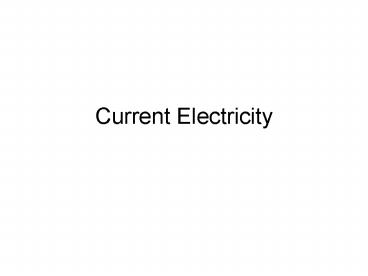Current Electricity PowerPoint PPT Presentation
1 / 21
Title: Current Electricity
1
Current Electricity
2
Electrodynamics the study of electrical charges
in motion
Electrostatics the study of electrical charges at
rest
Two opposite types of charge exist,
named positive and negative by Benjamin Franklin.
Charge is a property of matter.
3
Charged particles exist in atoms.
Electrons are responsible for negative
charge protons for positive charge neutrons
have no charge.
Small amounts of ordinary matter
contain incredible amounts of subatomic particles!
4
Conductor material that allows charges to move
about easily
link
Insulator material through which charges will not
easily move
5
Electric Potential Difference
the change in electric potential energy per unit
charge
V W/Q
The SI unit of electric potential difference is
the VOLT, named in honor of Alessandro Volta.
One VOLT is the electric potential
difference between two points when one Joule of
work is done in moving one Coulomb of
charge between the points.
6
electric cell - a device that converts one form
of energy to electrical energy
Chemical cells convert chemical energy into
electrical energy.
Chemical cells can be wet or dry.
7
Solar cells convert light energy into electrical
energy.
A generator converts mechanical energy into
electrical energy.
battery - two or more cells connected in series
or in parallel
8
the flow of charged particles can be positive
or negative, but usually negative (electrons)
through a conducting metal
9
Electric current is measured in Amperes, in honor
of Andre Marie Ampere.
One Ampere is the flow of one Coulomb of charge
per second.
1 Amp 1 Coulomb per second 1 C/s
I Q/t
10
Ammeter
a device that measures current
Voltmeter
a device that measures electric potential
difference
11
power work/time (work/charge).(charge/time)
electric potential difference . current P (Watts)
V (Volts).I (Amps)
12
Resistance
determines the amount of current flow
the ratio of potential difference to current
V
The SI unit of
resistance is the Ohm,
W, named in honor of Georg Simon Ohm.
R
I
One Ohm of resistance is the resistance such that
one Volt of potential difference is needed to
obtain a current of one Amp.
13
The resistance of a circuit element depends
on 1. the length of the conductor as length
increases, resistance increases
proportionally 2. the cross-sectional area of
the conductor as area increases, resistance
decreases proportionally 3. the resistivity of
the conductor as resistivity increases,
resistance increases proportionally
14
Ohms Law
The ratio of potential difference to current is
constant.
If R V/I is a constant value for a given
resistor, then that resistor is said to obey
Ohms Law.
15
Many circuit elements do not obey Ohms Law.
Resistors that get hot, like light bulbs and
heating elements, do not keep a constant
resistance. Resistance generally increases as
objects become hotter.
16
Resistor Circuits
Series
1. total resistance is the sum of the
separate resistors
RT R1 R2 R3 ...
2. current is the same through each resistor
IT I1 I2 I3 ...
3. total potential difference is the sum of each
VT V1 V2 V3 ...
In other words, in a series circuit, resistance
and voltage add, but current stays the same.
17
P, W
V, V
R, W
I, A
E 12 V
8.0
R1
2.0
R1
R3
R2
5.0
R3
RT
R2
VT
IT
PT
18
P, W
V, V
R, W
I, A
E 12 V
8.0
R1
0.80
6.4
5.1
2.0
0.80
1.6
1.3
R1
R3
R2
5.0
0.80
4.0
3.2
R3
RT 15 ?
R2
VT 12 V
IT 0.80 A
PT 9.6 W
19
Parallel
1. reciprocal of the total resistance is the
sum of the reciprocals of the separate
resistors
1/RT 1/R1 1/R2 1/R3 ...
2. total current is the sum of the current
through each resistor
IT I1 I2 I3 ...
3. potential difference is the same across
each resistor
VT V1 V2 V3 ...
In other words, in a parallel circuit,
resistance adds as reciprocals, voltage stays
the same, and current splits.
20
P, W
R, W
V, V
I, A
E 12 V
12
R1
8.0
R2
R1
12
R3
R2
RT
R3
VT
IT
PT
21
P, W
R, W
V, V
I, A
E 12 V
12
12
1.0
12
R1
1.5
8.0
12
18
R2
R1
12
1.0
12
12
R3
R2
RT 3.42 ?
R3
VT 12 V
IT 3.50 A
PT 42 W

